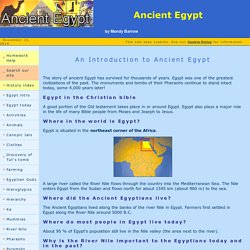

Ancient Egypt - Ancient Civilizations for Kids. North Africa Geography North Africa's landscape is covered by the world's largest hot desert--the Sahara.

This massive Arid climate makes it a strange place for a large population of people. Most of the Sahara is too harsh for people to live. The Nile Valley, coastal areas, and the rare oases (plural for oasis) provide the only places that can support life. An oasis is an area of natural water in a desert that allows plant life. For thousands of years the Nile has flooded when the rainy season begins in central Africa.
Early History The oldest human fossils have been found near North Africa, but the land was very different 200,000 years ago. 10,000 years ago North Africa was a grassland with many plants and animals. Egyptian Civilization Starting around 5500 BCE two major kingdoms developed along the Nile. Religion was a the center of Egyptian life. Egyptians were a very advanced civilization due to their inventions and technology. Ancient Egypt for Kids. The story of ancient Egypt has survived for thousands of years.

Egypt was one of the greatest civilizations of the past. The monuments and tombs of their Pharaohs continue to stand intact today, some 4,000 years later! A good portion of the Old testament takes place in or around Egypt. Egypt also plays a major role in the life of many Bible people from Moses and Joseph to Jesus. Ancient Egypt for Kids. Ancient Egypt, the Gift of the Nile. Like a giant snake, the Nile River slithers through some of the driest desert land on earth to create a narrow green valley.

The ancient Greeks called this land Egypt. Ancient Egypt. AncientEgyptMap.jpg (JPEG Image, 841x1474 pixels) Ancient Egypt Facts For Kids. Kids History: Ancient Egypt for Kids. Back to History Ancient Egypt was one of the greatest and most powerful civilizations in the history of the world.

It lasted for over 3000 years from 3150 BC to 30 BC. The Rise of Civilizations. History: Egyptians. ODYSSEY/Egypt. Neferchichi's Tomb at neferchichi.com. 114 Gods of Ancient Egypt, Ägyptische Götter. Gods and Goddesses. Egyptian Gods. Glossary of Major Gods. Virtual English Teaching Slot. Ancient Egyptian Gods. Find out about Egyptian Gods and try our challenge © 2012 This website is produced by the Student Recruitment, Admissions and International Development Division at The University of Manchester.

Gods and Goddesses. Ancient Egypt. Egypt's impact on later cultures was immense.

You could say that Egypt provided the building blocks for Greek and Roman culture, and, through them, influenced all of the Western tradition. Today, Egyptian imagery, concepts, and perspectives are found everywhere; you will find them in architectural forms, on money, and in our day to day lives. Many cosmetic surgeons, for example, use the silhouette of Queen Nefertiti (whose name means “the beautiful one has come”) in their advertisements. Pyramid of Khafre at Giza, c. 2520-2494 (right). Photo: Dr Amy Calvert, CC BY-NC This introduction will provide you with the primary filters to view and understand ancient Egypt. Longevity Ancient Egyptian civilization lasted for more than 3000 years and showed an incredible amount of continuity.
Consistency & Stability Egypt’s stability is in stark contrast to the Ancient Near East of the same period, which endured an overlapping series of cultures and upheavals with amazing regularity. Geography Dynasties. Rosicrucian Egyptian Museum in San Jose houses the largest collection of Egyptian artifacts on exhibit in western North America.
Tomb of Tutankhamun. Old Kingdom: Seated Scribe. Art History: Ancient Egypt. New Kingdom: Ramesses II. Narmerin ihomaalipaletti. History: Egyptians. Sumerian Myths. Sumerian civilization originated in what is now southern Iraq, just upriver from the mouths of the Tigris and Euphrates rivers.

"Civilization" in this context means a settled town or city-dwelling people who possess a stable agricultural technology (including domesticated animals) and have developed a hierarchical system of social classes (peasants, laborers, slaves, craftsmen [smiths, masons, carpenters, potters, etc.], farmers, fishermen, merchants, doctors, architects, priests and temple attendants, bureaucrats, scribes, advisers, priest-kings). Since the climate of southern Iraq is hot and dry, agriculture requires an extensive irrigation system of canals and dikes. Often, the Sumerians wrote as if their civilization (agricultural techniques, cities, classes of people) came first, and people later. (Why do you think they thought this way?) Map of Mesopotamian Archeological Sites (Oriental Institute, University of Chicago) The Creation of Humans Sumerian Creation Questions1. 2. 3. 4.